There are a wide variety of ships plying the waters from Europe to America, along the coast of Africa, around the Horn, between the islands of the Caribbean, in the Mediterranean and across the Pacific. The major powers, especially Britian, tend to have the most modern and effective ships in their navies (though there are exceptions.) While in the backwaters of distant colonies, local ship yards turn out varieties that are a century out of date but easy to build with limited manpower and materials. This list covers the most common types likely to be seen in Caribbean waters, on the Courses to England and Europe or along the coasts of North and South America.

The Parts of a Ship
BARK (BARQUE)
Before the 1700’s the name was applied to any small vessel. In the 18th century, the British Royal Navy used the term bark for a nondescript vessel which did not fit any of its usual categories. By the end of the 18th century it applied to a small ship having three masts. The first two being square-rigged, and the third ( aft mast ) being fore-and-aft rigged.
The advantage of these rigs was that they needed smaller (therefore cheaper) crews than a comparable ship or brig-rigged vessel.
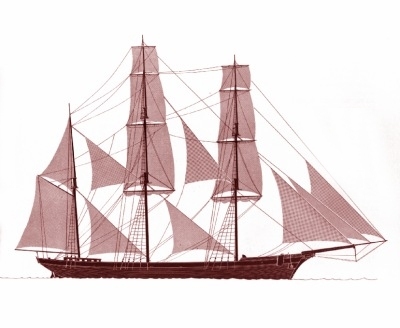
Barque
BRIGANTINE
The brigantine was originally a small ship carrying both sails and oars. It was a favorite of Mediterranean pirates from whence it got its name. Italian word brigantino meant…brigand’s ship.
In the late 17th century, the Royal Navy used the term brigantine to refer to small two-masted vessels designed to be rowed as well as sailed, rigged with square sails on both masts.
By the first half of the 18th century the word had evolved to refer not to a ship type name, but rather to a particular type of rigging: square rigged on the foremast and fore-and-aft rigged on the mizzen.
The 1780 Universal Dictionary of the Marine by William Falconer defines brig and brigantine as follows:
BRIG, or BRIGANTINE, a merchant-ship with two masts. This term is not universally confined to vessels of a particular construction, or which are masted and rigged in a method different from all others. It is variously applied, by the mariners of different European nations, to a peculiar sort of vessel of their own marine.
Among English seamen, this vessel is distinguished by having her main-sail set nearly in the plane of her keel; whereas the main-sails of larger ships are hung athwart, or at right angles with the ship’s length, and fastened to a yard which hangs parallel to the deck: but in a brig, the foremost edge of the main-sail is fastened in different places to hoops which encircle the main-mast, and slide up and down it as the sail is hoisted or lowered: it is extended by a gaff above, and by a boom below.
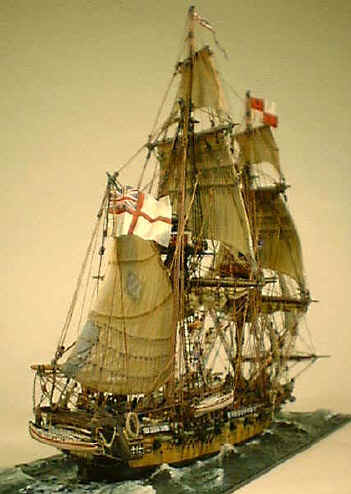
Brig
Later, brig and brigantine developed distinct meanings. The Oxford English Dictionary (with citations from 1720 to 1854) defines brig as:
1. a. A vessel
(a) originally identical with the brigantine (of which word brig was a colloquial abbreviation); but, while the full name has remained with the unchanged brigantine, the shortened name has accompanied the modifications which have subsequently been made in rig, so that a brig is now
(b) A vessel with two masts square-rigged like a ship’s fore- and main-masts, but carrying also on her main-mast a lower fore-and-aft sail with a gaff and boom.
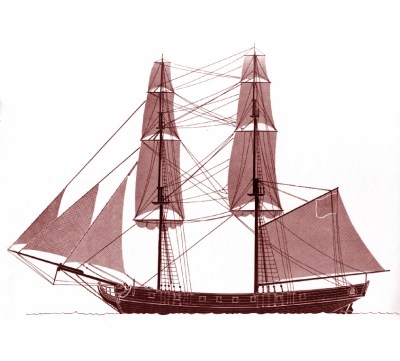
Brigantine
A brig differs from a snow in having no try-sail mast, and in lowering her gaff to furl the sail. Merchant snows are often called brigs. This vessel was probably developed from the brigantine by the men-of-war brigs, so as to obtain greater sail-power. Also they were often used by pirates.
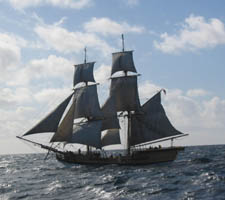
Brig
CARAVEL
A small ship meant for trading. Originally lateen-rigged they later developed into square-masted ships and were used by the Spanish and Portuguese for exploration. By the mid 16th century they have all but vanished for long sea voyages but are still found as coastal traders along the Spanish Main and in parts of Africa and the Far East, having been built in local shipyards for local use.
Early caravels were usually two-masted boats of around 50 tons with an overall length of between 20–30 m and a high length-to-beam ratio of around 3.5:1 and narrow ellipsoidal (not circular as in the Nao) frames making them very fast and maneuverable but with somewhat low capacity. Towards the end of the 15th century the caravel was occasionally modified by giving it the same rig as a carrack with a foresail, square mainsail and lateen mizzen, but, unlike the unweatherly carrack, the caravel did not have a high forecastle or much of a sterncastle. In this form it was sometimes known as caravela redonda (a bulging square sail is said to be round or redonda in the Iberian tradition)
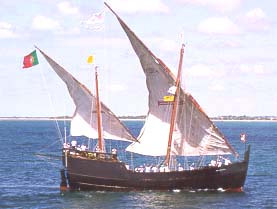
Caravel
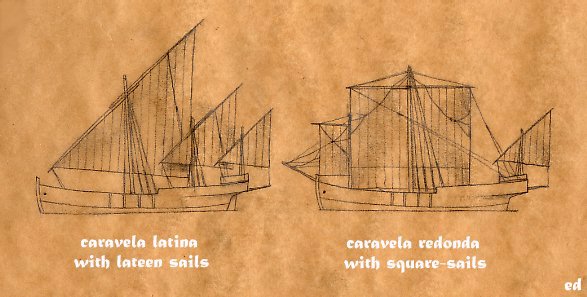
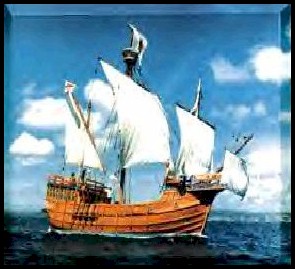
Caravel
In the first half of the 16th century, a specialized fighting ship with that same name caravela redonda was created by the portuguese to act as an escort in Brazil and in the East Indies route. It had a foremast with square sails and three other masts with a lateen each to a total of 4 masts. The hull was galleon-shaped (some experts consider this vessel a forerunner of the fighting galleon). The Portuguese Man o’ War was named after this curious fighting ship type which was in use until the 18th century.
Fluyt
A sailing vessel originally designed as a dedicated cargo vessel. Originating from the Netherlands in the 16th Century, the vessel was designed to facilitate transoceanic delivery with the maximum of space and crew efficiency. It usually carried 12 to 15 cannons, but was still an easy target for pirates. The design minimized crew requirements due to its extensive use of block and tackle to facilitate ship operations. Designers and owners frequently eliminated its armaments to maximize available cargo space and profitability. This ship class was credited in enhancing Dutch competitiveness in international trade, and was widely employed by the Dutch East India Company in the 17th and 18th centuries. However it gained such popularity beyond its native waters that it was soon in use by other sea faring nations.
The design of fluyts was largely similar to that of the early galleons. It generally weighed 200-300 tons and was 80 feet long. The pear-shaped vessel had a large cargo bay near the waterline and a relatively narrow deck above. The fluyt was square rigged with two or three masts. At times fluyts were also armed and served as auxiliary vessels, which was a common practice in the Baltic Sea.
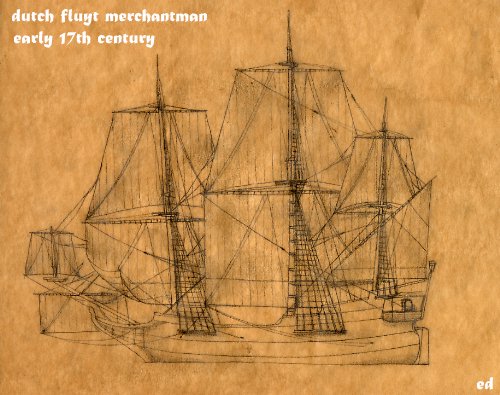
Dutch Fluyt
GALLEON
Galleons were large ships meant for transporting cargo. Galleons were sluggish behemoths, not able to sail into or near the wind. The Spanish treasure fleets were made of these ships. Although they were sluggish, they weren’t the easy target you would expect for they could carry heavy cannon which made a direct assault upon them difficult. She had two to three decks. Most had three masts, forward masts being square-rigged, lateen-sails on the mizzenmast, and a small square sail on her high-rising bowsprit. Some galleons sported 4 masts but these were an exception to the rule.
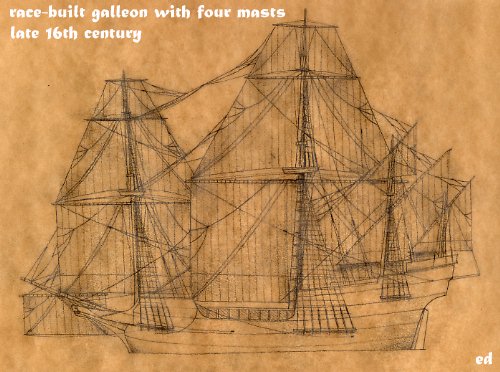
Galleon
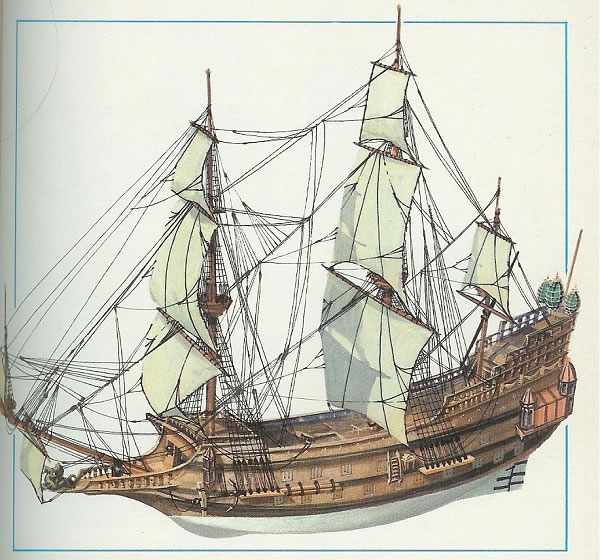
French Galleon
LONGBOAT, CUTTERS, GIGS, DINGHYS, DORYS and JOLLY BOATS
LONGBOAT
Much like a rowboat except they were very long. They were carried on ships and used for coming and going to the ship. The longboat is an open, primarily rowing, boat with eight or ten oarsmen, two per thwart. In other words the longboat was double banked: its rowing benches were designed to accommodate two men. Unlike the dinghy or the cutter, the longboat would have fairly fine lines aft to permit its use in steep waves such as surf or wind against tide where need be.
It had the double-banked arrangement in common with the cutter. This was possible as it had a beam similar to a cutter’s but broader than that of a gig, which was single banked. They were normally rowed but often had a removable mast and sail and have been used for extended voyages when circumstances warranted. A single swivel gun or Falconet is sometimes mounted on a longboat.
The longboat was generally more seaworthy than the cutter which had a fuller stern for such load-carrying work as laying out an anchor and cable. In a seaway or surf therefore, the cutter was more prone to broaching to.
The open Cutter carried aboard naval vessels in the 18th Century was rowed by pairs of men sitting side-by-side on benches. The cutter, with its transom, was broader in proportion compared to the longboat, which had finer lines.
A dinghy or gig, sometimes called a ‘Jolly Boat’ or a ‘Cock Boat’ is a small utility boat carried by a larger vessel, though they are also found in harbors as general utility boats and for hire to transport people out to anchored ships. A gig was smaller and lighter than the longboat or the cutter. It was usually crewed by 4 select oarsmen, and a coxswain. Generally the oarsmen sat one to a seat, but each only rowed a single oar on alternating sides. The gig was not as sea kindly as the longboat, but was used mostly in harbors.
The gigs generally had a high wineglass transom, full skeg, full keel, straight stem and somewhat rounded sides. There was in general very little rocker in the keel. And the gunwales on many were nearly straight from bow to stern.

Long Boat under sail
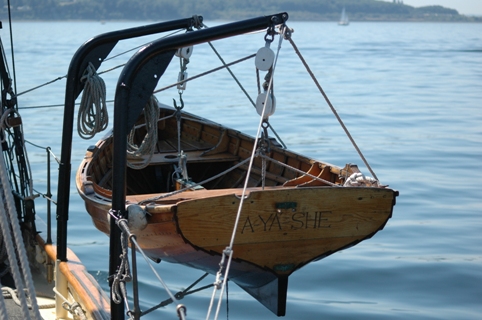
Dinghy
A Dory (dorey) is a small, shallow-draft boat of approximately 15 to 22 ft in length. Lightweight and versatile, these boats are used in the open sea for fishing, as well as on interior rivers. Most dory versions usually seat from two or three to four people including the oarsman. The dory can be easily rowed by one person.
The hull is characterized by flat sides angled approx. 30 degrees from the vertical, and a bottom that is transversely flat and markedly bowed fore-and-aft. (This curvature is known as ‘rocker’.) The stern is frequently a raked surface (a narrow transom) that tapers sharply toward the bottom forming a nearly double-ended boat.
Nested stacks of dories are frequently carried on the decks of fishing schooners out to the fishing grounds, where they are deployed to lay longlines or tend nets.
Small mast and sail can be used with a dory but it is a very small boat for an extended voyage.
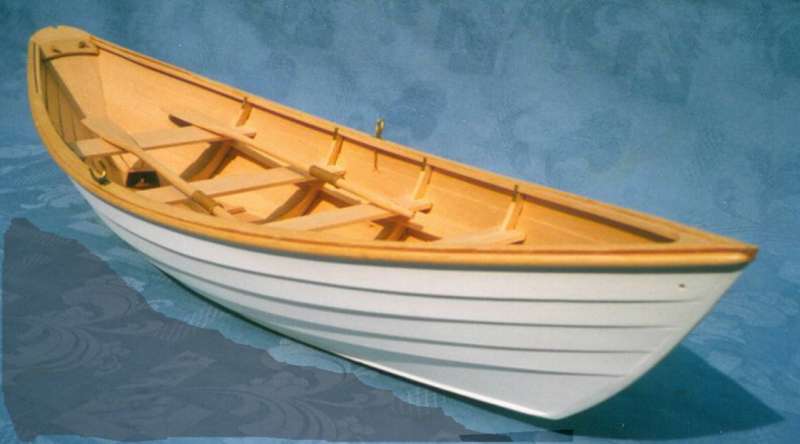
Dorey
MERCHANT (PINK)
There are two types of Pink.
The first was a small, flat-bottomed ship with a narrow stern. This ship was derived from the Italian pinco. It was used primarily in the Mediterranean as a cargo ship and is able to travel up rivers with considerable ease.
In the Atlantic the word pink was used to describe any small ship with a narrow stern, having derived from the Dutch word pincke. They have a large cargo capacity, they are generally square rigged and somewhat slow and sluggish to handle. However, they have better maneuverability in shallow waters than some similar classes of ship. They are most often used for short-range missions in protected channels, as both merchantmen and warships.
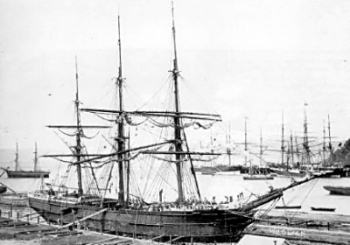
Merchant (Pink)
SCHOONER
A type of sailing vessel that uses fore-and-aft sails on two or more masts. Schooners were first used by the Dutch in the 16th or 17th century
The Schooner has a narrow hull, two masts and is usually less than 100 tons.
Two masted schooners were and are most common. They are popular in trades that required speed and windward ability, such as slaving, privateering, blockade running and offshore fishing. They also came to be favoured as pilot vessels. There is no set number of masts for a schooner. A small schooner has two or three masts, but they were built with as many as six (e.g. the wooden six-masted Wyoming) or seven masts to carry a larger volume of cargo. Two Masted Schooner[/caption]
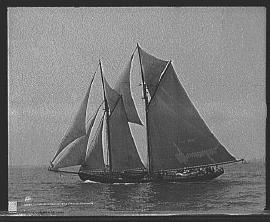
Two Masted Schooner
SLOOP
The Sloop was fast, agile, and had a shallow draft. There were different types of sloop. While the commercial or recreational view of the sloop is of a single-masted vessel, in naval usage the sloops were almost always either three-masted (i.e. “ship rigged”) or two-masted. The latter were sub-divided according to the type of sailing rig carried on its two masts. In the first half of the 18th century, most naval sloops were two-masted vessels, usually carrying a ketch or a snow rig. The difference was that a ketch carried main and mizzen masts but had no foremast, while in a snow the two masts were the foremast and the main mast (but no mizzen).
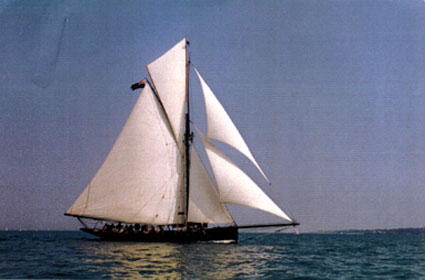
Single Mast Sloop
A sloop-of-war was quite different from a civilian or mercantile sloop, which was a general term for a single masted vessel rigged like what we would today call a gaff cutter (but usually without the square topsails then carried by cutter-rigged vessels); some sloops of this other type nevertheless served in the 18th century British Royal Navy, particularly on the Great Lakes of North America. The Royal Navy also made extensive use of the Bermuda sloop, both as a cruiser against French privateers, slavers, and smugglers, and as its standard advice vessels, carrying communications, vital persons and materials, and providing reconnaissance for the fleets.
In the 18th century, a sloop-of-war was a small sailing warship (also known as one of the escort types) with a single gun deck that carried anything up to eighteen cannon. As the rating system covered all vessels with 20 guns and above, this meant that the term sloop-of-war actually encompassed all the unrated combat vessels including the very small gun-brigs and cutters. In technical terms, even the more specialised bomb vessels and fireships were classed as sloops-of-war, and in practice these were actually employed in the sloop role when not carrying out their specialised functions.
A sloop-of-war was smaller than a sailing frigate and outside the rating system. In general, a sloop-of-war would be under the command of a master and commander rather than a post captain, although in day-to-day use at sea the commanding officer of any naval vessels would be addressed as “captain”. Until 1794 the master and commander strictly speaking held the permanent rank of lieutenant, and reverted to that rank when he gave up command of the sloop-of-war; in 1794 the rank of commander was created. A ship sloop was generally the equivalent of the smaller corvette of the French Navy (although the French term also covered ships up up to 24 guns, which were classed as ‘post ships’ within the Sixth Rate of the British Navy).
A Snow (pronounced “snoo”) or snaw, is a type of brig — snows are often-referred to as “snow-brigs” — snows were primarily used as a merchant ship, but saw war service.
Snows carried square sails on both masts, but had a small trysail mast, sometimes called a ‘snowmast’, stepped immediately abaft the mainmast. This mast could carry a trysail with a boom, with the luff of the trysail hooped to it. Sometimes, instead of a trysail mast, snows carried a horse on the mainmast, with the luff of the trysail attached to it by rings.

Snow (Snau)
Ketch
A ketch is a sailing craft with two masts: a main mast, and a shorter mizzen mast abaft (rearward of) the main mast. Both masts are rigged mainly fore-and-aft. From one to three jibs may be carried forward of the main mast when going to windward. If a ketch is not rigged for jibs it is called a cat ketch, sometimes called a periauger. On older, larger ketches the main mast may in addition carry one or more square rigged topsails. A ketch may also carry extra sails, see below.
The ketch is popular among long distance cruisers as the additional sail allows for a better balance, and a smaller more easily handled mainsail for the same overall sail area. It also allows sailing on mizzen and jib only without introducing excessive lee helm, and in an emergency can be quite well steered without use of the rudder.
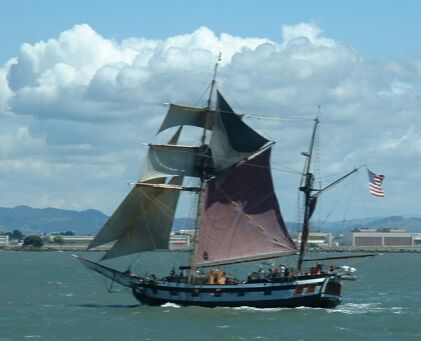
Ketch
